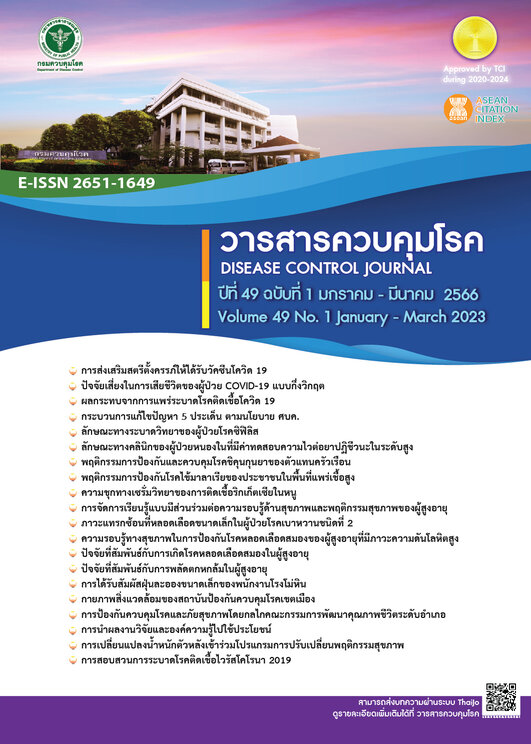Microvascular complication among type II diabetes mellitus patients with poor glycemic control in Samut Prakan Hospital: a survival analysis
DOI:
https://doi.org/10.14456/dcj.2023.11Keywords:
type 2 Diabetes, uncontrolled diabetes mellitus patient, microvascular complicationAbstract
Diabetes Mellitus has been the global public health problem. The uncontrolled diabetes mellitus creates a higher risk of diabetes complications. This study aimed to explain and identify factors affecting microvascular complications among type II diabetes patients. The total of 1,006 medical records of registered diabetes patients who experienced uncontrolled blood sugar levels from October 2016 to September 2020 were reviewed. The results showed that the incidence of microvascular complication was 17.2%, and the average forming duration of diabetic peripheral neuropathy revealed the shortest duration of complication occurrence at 2.14 years. Factors significantly related to the occurrence of microvascular complications were sex (HR=1.40; p=0.037), insurance (HR=1.87; p=0.011), and history of insulin prescription (HR=1.69; p=0.006). Strengthening the health promotion program provided to uncontrolled diabetes patients is suggested in order to alleviate risks of microvascular complications.
Downloads
References
Diabetes association of Thailand. Clinical practice guideline for diabetes 2017. 3rd ed. Pathum Thani: Diabetes association of Thailand; 2017. (in Thai)
Ogurtsova K, da Rocha Fernandes JD, Huang Y, Linnenkamp U, Guariguata L, Cho NH, et al. IDF Diabetes Atlas: Global estimates for the prevalence of diabetes for 2015 and 2040. Diabetes Res Clin Pract. 2017;128:40-50.
Saeedi P, Petersohn I, Salpea P, Malanda B, Karuranga S, Unwin N, et al. Global and egional diabetes prevalence estimates for 2019 and projections for 2030 and 2045: Results from the International Diabetes Federation Diabetes Atlas, 9th ed. Diabetes Res Clin Pract. 2019;157:1-9(107843).
Cho NH, Shaw JE, Karuranga S, Huang Y, da Rocha Fernandes JD, Ohlrogge AW, et al. IDF Diabetes Atlas: Global estimates of diabetes prevalence for 2017 and projections for 2045. Diabetes Res Clin Pract. 2018;138:271-81.
Khan MAB, Hashim MJ, King JK, Govender RD, Mustafa H, Al Kaabi J. Epidemiology of Type 2 Diabetes Global Burden of Disease and Forecasted Trends. J Epidemiol Glob Health. 2020;10(1):107-11.
Laotaveerungrueng N, Wanthong S, Wannachalee T, Lertwattanarak R. Prevalence of chronic microvascular complications and diabetic foot problems in patients with diabetes mellitus at siriraj hospital. J Med Assoc Thai. 2018;101(10):1349-55 (in Thai).
Zhang P, Lu J, Jing Y, Tang S, Zhu D, Bi Y. Global epidemiology of diabetic foot ulceration: a systematic review and meta-analysis. Ann Med. 2017;49(2):106-16.
Hoque S, Muttalib MA, Islam MI, Happy AT. Evaluation of Different HbA1c Levels To Assess the Risk of Peripheral Neuropathy Among Type 2 Diabetic Patients Along With Other Conventional Risk Factors. Bangladesh Med Res Counc Bul. 2016;42:95-103.
Karki DB, Yadava SK, Pant S, Thusa N, Dangol E, S1 G. Prevalence of Sensory Neuropathy in Type 2 Diabetes Mellitus and Its Correlation with Duration of Disease. Kathmandu Univ Med J (KUMJ). 2016;14(54):120-24.
Gray N, Picone G, Sloan F, Yashkin A. Relation between BMI and diabetes Mellitus and its complications among US older adults. South Med J. 2015;108(1):29-36.
Papanas N, Ziegler D. Risk Factors and Comorbidities in Diabetic Neuropathy: An Update 2015. Rev Diabet Stud. 2015;12(1-2):48-62.
Aisha Q, Sumera S, Lubna N, Ghazala Y, Nazish I. Prevalence of Risk Factors Promoting Diabetic Neuropathy: Pak J Neurological Sci. 2019;14(2):16-23.
Laiteerapong N, Ham SA, Gao Y, Moffet HH, Liu JY, Huang ES, et al. The Legacy Effect in Type 2 Diabetes: Impact of Early Glycemic Control on Future Complications (The Diabetes & Aging Study). Diabetes Care. 2019;42(3):416-26.
Liu X, Xu Y, An M, Zeng Q. The risk factors for diabetic peripheral neuropathy: A meta-analysis. PloS one. 2019;14(2):e0212574.
Sabanayagam C, Banu R, Chee ML, Lee R, Wang YX, Tan G, et al. Incidence and progression of diabetic retinopathy: a systematic review. Lancet Diabetes Endocrinol. 2019;7(2):140-9.
El Haddad OA, Saad MK. Prevalence and risk factors for diabetic retinopathy among Omani diabetics. Br J Ophthalmol. 1998;82(8):901-6.
Strategy and Planning Division, Office of the Ministry of Public Health permanent seretary (TH). Public health resources information report 2019. n.p.; 2019
Hoque S, Muttalib MA, Islam MI, Happy AT. Evaluation of Different HbA1c Levels to Assess the Risk of Peripheral Neuropathy Among Type 2 Diabetic Patients Along with Other Conventional Risk Factors. Bangladesh Med Res Counc Bul. 2016;42:95-103.
Singh SS, Roeters-van Lennep JE, Lemmers RFH, van Herpt TTW, Lieverse AG, Sijbrands EJG, et al. Sex difference in the incidence of microvascular complications in patients with type 2 diabetes mellitus: a prospective cohort study. Acta Diabetol. 2020;57(6):725-32.
Huo X, Zhang J, Guo X, Lu J, Li J, Zhao W, et al. Gender Difference in the Association of Early- vs. Late-Onset Type 2 Diabetes with Non-Fatal Microvascular Disease in China: A Cross-sectional Study. Front Endocrinol (Lausanne). 2018;9:1-15.
Orem DE. Nursing: Concepts of practice Health Promotion. WHO Publication. 1988.
Hurst C, Thinkhamrop B, Tran HT. The Association between Hypertension Comorbidity and Microvascular Complications in Type 2 Diabetes Patients: A Nationwide Cross-Sectional Study in Thailand. Diabetes Metab J. 2015;39(5):395-404.
Zhao H, Shu L, Huang W, Wang W, Song G. Difference Analysis of Related Factors in Macrovascular and Microvascular Complications In Chinese Patients With Type 2 Diabetes Mellitus: A Case-Control Study Protocol. Diabetes Metab Syndr Obes. 2019;12:2193-200.
Downloads
Published
How to Cite
Issue
Section
License
Copyright (c) 2023 Disease Control Journal

This work is licensed under a Creative Commons Attribution-NonCommercial-NoDerivatives 4.0 International License.
Articles published in the Disease Control Journal are considered as academic work, research or analysis of the personal opinion of the authors, not the opinion of the Thailand Department of Disease Control or editorial team. The authors must be responsible for their articles.






